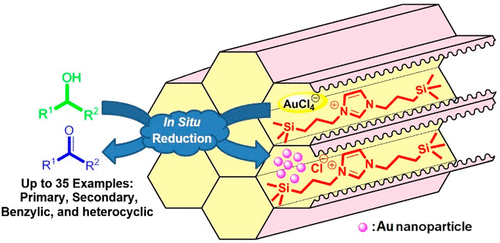当前位置:
X-MOL 学术
›
ACS Comb. Sci.
›
论文详情
Our official English website, www.x-mol.net, welcomes your feedback! (Note: you will need to create a separate account there.)
Aerobic Oxidation of Alcohols Catalyzed by in Situ Generated Gold Nanoparticles inside the Channels of Periodic Mesoporous Organosilica with Ionic Liquid Framework.
ACS Combinatorial Science ( IF 3.903 ) Pub Date : 2020-01-27 , DOI: 10.1021/acscombsci.9b00160 Babak Karimi 1, 2 , Akram Bigdeli 1 , Ali Asghar Safari 1 , Mojtaba Khorasani 1, 2 , Hojatollah Vali 3 , Somaiyeh Khodadadi Karimvand 1
ACS Combinatorial Science ( IF 3.903 ) Pub Date : 2020-01-27 , DOI: 10.1021/acscombsci.9b00160 Babak Karimi 1, 2 , Akram Bigdeli 1 , Ali Asghar Safari 1 , Mojtaba Khorasani 1, 2 , Hojatollah Vali 3 , Somaiyeh Khodadadi Karimvand 1
Affiliation

|
In situ generated gold nanoparticles inside the nanospaces of periodic mesoporous organosilica with an imidazolium framework (Au@PMO-IL) were found to be highly active, selective, and reusable catalysts for the aerobic oxidation of activated and nonactivated alcohols under mild reaction conditions. The catalyst was characterized by nitrogen adsorption-desorption measurement, thermogravimetric analysis (TGA), transmission electron microscopy (TEM), elemental analysis (EA), diffuse reflectance infrared Fourier transform spectroscopy (DRIFT), X-ray photoelectron spectroscopy (XPS), and inductively coupled plasma atomic emission spectroscopy (ICP-AES). The catalyst exhibited excellent catalytic activity in the presence of either Cs2CO3 (35 °C) or K2CO3 (60 °C) as reaction bases in toluene as a reaction solvent. Under both reaction conditions, various types of alcohols (up to 35 examples) including activated benzylic, primary and secondary aliphatic, heterocyclic, and challenging cyclic aliphatic alcohols converted to the expected carbonyl compounds in good to excellent yields and selectivity. The catalyst was also recovered and reused for at least seven reaction cycles. Data from three independent leaching tests indicated that amounts of leached gold particles were negligible (<0.2 ppm). It is believed that the combination of bridged imidazolium groups and confined nanospaces of PMO-IL might be a major reason explaining the remarkable stabilization and homogeneous distribution of in situ generated gold nanoparticles, thus resulting in the highly active and recyclable catalyst system.
中文翻译:

在具有离子液体骨架的周期性介孔有机二氧化硅的通道内原位生成的金纳米颗粒催化醇的有氧氧化。
在具有咪唑骨架的周期性介孔有机二氧化硅(Au@PMO-IL)的纳米空间内原位生成的金纳米颗粒被发现是一种高活性、选择性和可重复使用的催化剂,用于在温和的反应条件下对活性和非活性醇进行有氧氧化。该催化剂通过氮吸附-解吸测量、热重分析 (TGA)、透射电子显微镜 (TEM)、元素分析 (EA)、漫反射红外傅里叶变换光谱 (DRIFT)、X 射线光电子能谱 (XPS) 和电感耦合等离子体原子发射光谱 (ICP-AES)。该催化剂在以甲苯为反应溶剂的 Cs2CO3 (35 °C) 或 K2CO3 (60 °C) 作为反应碱存在下表现出优异的催化活性。在两种反应条件下,各种类型的醇(最多 35 个示例),包括活化的苄醇、伯醇和仲脂肪醇、杂环醇和具有挑战性的环状脂肪醇,以良好到出色的产率和选择性转化为预期的羰基化合物。催化剂也被回收并重复使用至少七个反应循环。来自三个独立浸出试验的数据表明浸出金颗粒的量可以忽略不计(<0.2 ppm)。据信,桥接咪唑基团和 PMO-IL 的受限纳米空间的结合可能是解释原位生成的金纳米颗粒具有显着稳定性和均匀分布的主要原因,从而产生高活性和可回收的催化剂体系。杂环和具有挑战性的环状脂肪醇以良好的收率和选择性转化为预期的羰基化合物。催化剂也被回收并重复使用至少七个反应循环。来自三个独立浸出试验的数据表明浸出金颗粒的量可以忽略不计(<0.2 ppm)。据信,桥接咪唑基团和 PMO-IL 的受限纳米空间的结合可能是解释原位生成的金纳米颗粒具有显着稳定性和均匀分布的主要原因,从而产生高活性和可回收的催化剂体系。杂环和具有挑战性的环状脂肪醇以良好的收率和选择性转化为预期的羰基化合物。催化剂也被回收并重复使用至少七个反应循环。来自三个独立浸出试验的数据表明浸出金颗粒的量可以忽略不计(<0.2 ppm)。据信,桥接咪唑基团和 PMO-IL 的受限纳米空间的结合可能是解释原位生成的金纳米颗粒具有显着稳定性和均匀分布的主要原因,从而产生高活性和可回收的催化剂体系。催化剂也被回收并重复使用至少七个反应循环。来自三个独立浸出试验的数据表明浸出金颗粒的量可以忽略不计(<0.2 ppm)。据信,桥接咪唑基团和 PMO-IL 的受限纳米空间的结合可能是解释原位生成的金纳米颗粒具有显着稳定性和均匀分布的主要原因,从而产生高活性和可回收的催化剂体系。催化剂也被回收并重复使用至少七个反应循环。来自三个独立浸出试验的数据表明浸出金颗粒的量可以忽略不计(<0.2 ppm)。据信,桥接咪唑基团和 PMO-IL 的受限纳米空间的结合可能是解释原位生成的金纳米颗粒具有显着稳定性和均匀分布的主要原因,从而产生高活性和可回收的催化剂体系。
更新日期:2020-01-29
中文翻译:

在具有离子液体骨架的周期性介孔有机二氧化硅的通道内原位生成的金纳米颗粒催化醇的有氧氧化。
在具有咪唑骨架的周期性介孔有机二氧化硅(Au@PMO-IL)的纳米空间内原位生成的金纳米颗粒被发现是一种高活性、选择性和可重复使用的催化剂,用于在温和的反应条件下对活性和非活性醇进行有氧氧化。该催化剂通过氮吸附-解吸测量、热重分析 (TGA)、透射电子显微镜 (TEM)、元素分析 (EA)、漫反射红外傅里叶变换光谱 (DRIFT)、X 射线光电子能谱 (XPS) 和电感耦合等离子体原子发射光谱 (ICP-AES)。该催化剂在以甲苯为反应溶剂的 Cs2CO3 (35 °C) 或 K2CO3 (60 °C) 作为反应碱存在下表现出优异的催化活性。在两种反应条件下,各种类型的醇(最多 35 个示例),包括活化的苄醇、伯醇和仲脂肪醇、杂环醇和具有挑战性的环状脂肪醇,以良好到出色的产率和选择性转化为预期的羰基化合物。催化剂也被回收并重复使用至少七个反应循环。来自三个独立浸出试验的数据表明浸出金颗粒的量可以忽略不计(<0.2 ppm)。据信,桥接咪唑基团和 PMO-IL 的受限纳米空间的结合可能是解释原位生成的金纳米颗粒具有显着稳定性和均匀分布的主要原因,从而产生高活性和可回收的催化剂体系。杂环和具有挑战性的环状脂肪醇以良好的收率和选择性转化为预期的羰基化合物。催化剂也被回收并重复使用至少七个反应循环。来自三个独立浸出试验的数据表明浸出金颗粒的量可以忽略不计(<0.2 ppm)。据信,桥接咪唑基团和 PMO-IL 的受限纳米空间的结合可能是解释原位生成的金纳米颗粒具有显着稳定性和均匀分布的主要原因,从而产生高活性和可回收的催化剂体系。杂环和具有挑战性的环状脂肪醇以良好的收率和选择性转化为预期的羰基化合物。催化剂也被回收并重复使用至少七个反应循环。来自三个独立浸出试验的数据表明浸出金颗粒的量可以忽略不计(<0.2 ppm)。据信,桥接咪唑基团和 PMO-IL 的受限纳米空间的结合可能是解释原位生成的金纳米颗粒具有显着稳定性和均匀分布的主要原因,从而产生高活性和可回收的催化剂体系。催化剂也被回收并重复使用至少七个反应循环。来自三个独立浸出试验的数据表明浸出金颗粒的量可以忽略不计(<0.2 ppm)。据信,桥接咪唑基团和 PMO-IL 的受限纳米空间的结合可能是解释原位生成的金纳米颗粒具有显着稳定性和均匀分布的主要原因,从而产生高活性和可回收的催化剂体系。催化剂也被回收并重复使用至少七个反应循环。来自三个独立浸出试验的数据表明浸出金颗粒的量可以忽略不计(<0.2 ppm)。据信,桥接咪唑基团和 PMO-IL 的受限纳米空间的结合可能是解释原位生成的金纳米颗粒具有显着稳定性和均匀分布的主要原因,从而产生高活性和可回收的催化剂体系。


























 京公网安备 11010802027423号
京公网安备 11010802027423号